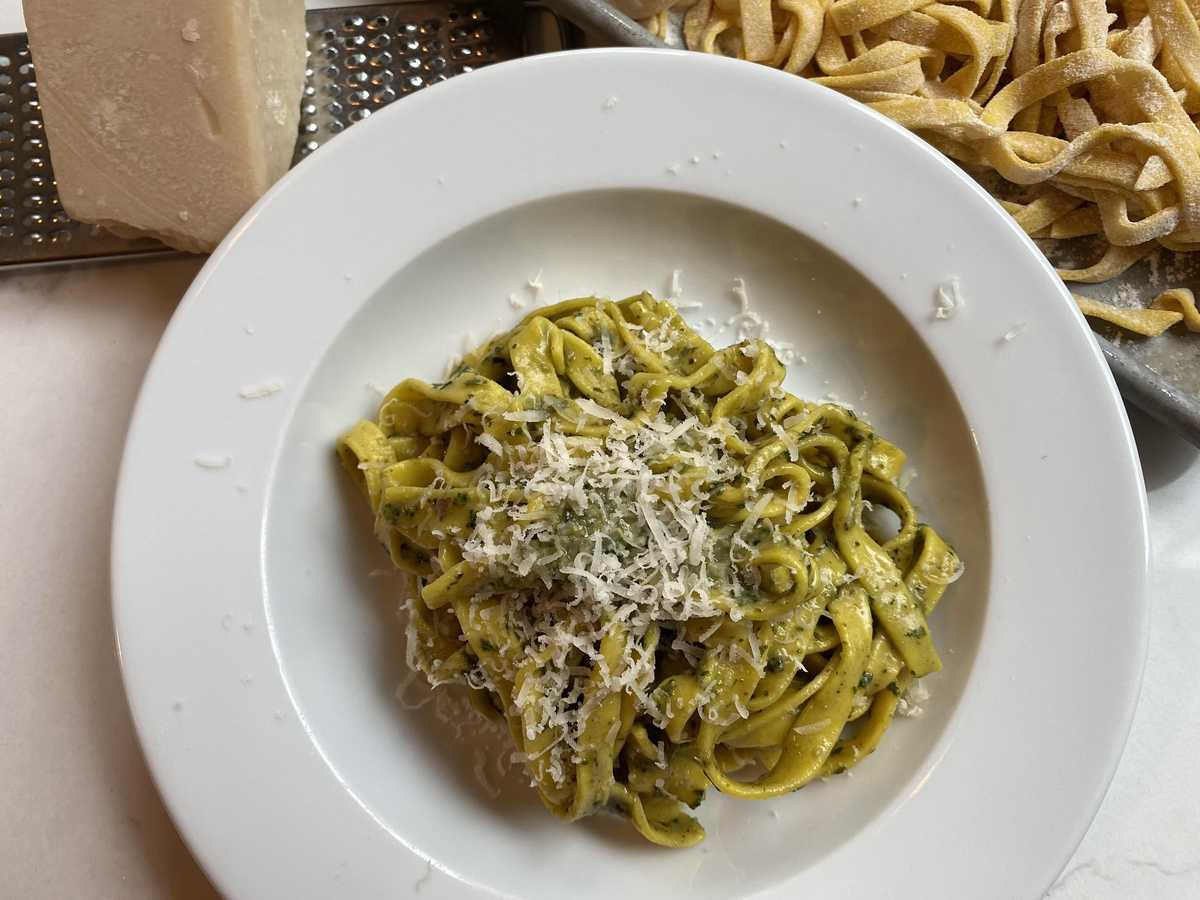
I love preparing homemade pasta because it’s a really fun activity with extremely delicious results. One of our most popular classes at The Chopping Block, and my favorite class to teach, is our Homemade Pasta and Gnocchi Workshop. I enjoy teaching people how to prepare new dishes they didn’t think were possible in their home kitchens. It brings me joy to see our students learn new skills and have a lot of fun along the way.
Our April class calendar was just released and you’ll see several pops of spring throughout the menus, including the pasta and gnocchi menu. In this class, we always make a long noodle such as fettuccine, a filled pasta such as ravioli, and potato gnocchi. Each pasta is served with a simple, seasonal sauce with the emphasis being on the pasta and gnocchi, and the sauce playing a supporting role.
Fresh pasta can seem like an intimidating project, but it’s much more approachable than most people think. The dough only consists of four ingredients: 00 flour (you can substitute all-purpose flour), semolina flour, eggs and a splash of water. You can make the dough by hand or in a food processor, which is what I do. The dough comes together in a matter of minutes, making the process even easier.
If making the dough by hand, measure your dry ingredients in a bowl, and make a well in the center. Crack your eggs into the center of the dough, add your water, and beat the eggs with a fork. Slowly start to mix the flour into the egg mixture until you have a shaggy dough. Turn the dough out onto your work surface, and knead until smooth and elastic, about 5 minutes. Wrap in plastic and allow to rest for at least 20 minutes.
If making the dough in a food processor, measure your dry ingredients in the bowl of a food processor and pulse to combine. Add the eggs and water, and process until the dough forms a ball. Transfer the dough to your work surface, and knead for about 1 minute to smooth out the dough. Wrap in plastic and allow to rest for at least 20 minutes.
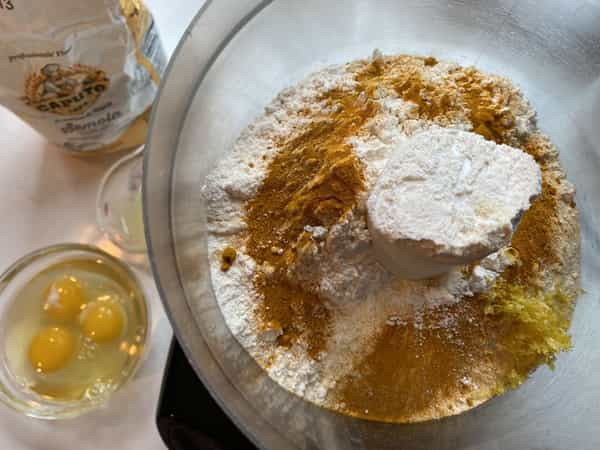
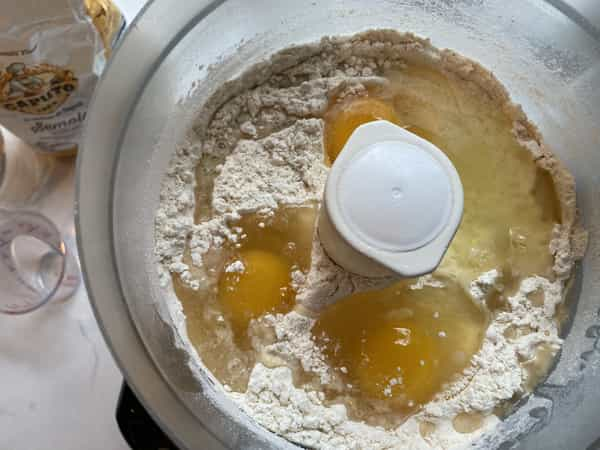
 The great thing about making pasta dough from scratch, is that you can personalize the dough and add additional ingredients for flavor and color. Here are some ideas:
The great thing about making pasta dough from scratch, is that you can personalize the dough and add additional ingredients for flavor and color. Here are some ideas:
- Spinach Dough: Blend your eggs with 1 cup baby spinach leaves*
- Beet Dough: Blend your eggs with 1 large roasted and peeled beet*
- Roasted Red Pepper Dough: Blend your eggs with 1 roasted red pepper*
- Squid Ink Dough: Add 2 tablespoons squid ink to your eggs*
- Fresh Herb Dough: Mix chopped, fresh herbs of your choice with your dry ingredients
*No additional water is needed due to the extra moisture from the added ingredients
When creating the spring menu for the pasta and gnocchi class, I developed a lemon fettuccine recipe to brighten up the menu. Of all the homemade pasta I have made, I have never made lemon-flavored pasta until today! To make the dough lemony, I added the zest of one lemon to my dry ingredients along with 1 teaspoon ground turmeric. This is to give the dough a yellowish color and make it look more lemony. In place of the water in the dough, I added 3 tablespoons of lemon juice.
 I made my pasta dough in the food processor, transferred it to my work surface, kneaded it just a few times to smooth it out, and then wrapped it in plastic wrap to rest for 20 minutes. Just before you roll out the dough, be sure to cut the dough in half; only half the dough will fit through the rollers at a time.
I made my pasta dough in the food processor, transferred it to my work surface, kneaded it just a few times to smooth it out, and then wrapped it in plastic wrap to rest for 20 minutes. Just before you roll out the dough, be sure to cut the dough in half; only half the dough will fit through the rollers at a time.
 To roll out pasta dough, it’s best to have a pasta machine. Alternatively, you can use a rolling pin which works well, but takes skill and time. There are also many doughs that are hand shaped that don’t require a pasta machine at all such as orecchiette and busiate.
To roll out pasta dough, it’s best to have a pasta machine. Alternatively, you can use a rolling pin which works well, but takes skill and time. There are also many doughs that are hand shaped that don’t require a pasta machine at all such as orecchiette and busiate.
Every pasta machine is a little bit different, but make sure you start with the rollers furthest apart from each other. After you roll the dough through the widest setting, you’ll notice it’s quite tapered on each end. To square it off, trifold the dough, and run it through the widest setting again.
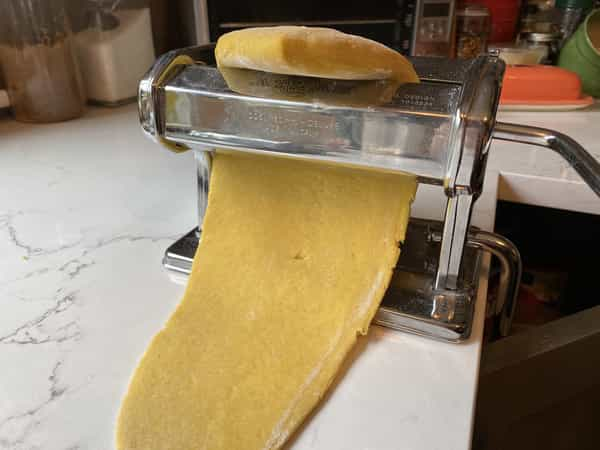
 Turn the dial on the side of the pasta machine one notch, and roll the dough through again. Repeat this process until you have the thinness of your choice. I personally don’t like my pasta sheets to be too thin because I like chewier noodles. On my Atlas machine, I go to number five on the dial.
Turn the dial on the side of the pasta machine one notch, and roll the dough through again. Repeat this process until you have the thinness of your choice. I personally don’t like my pasta sheets to be too thin because I like chewier noodles. On my Atlas machine, I go to number five on the dial.
Cut your super long sheet of pasta dough into noodle-length pieces, flour the sheets on both sides to prevent the noodles from sticking together, and run the sheets through the fettuccine cutter.
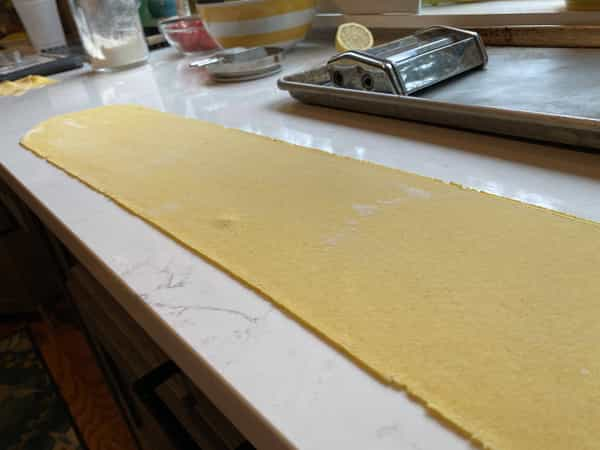
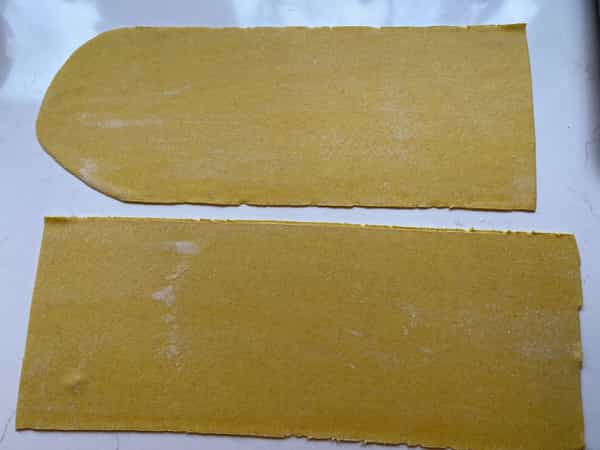
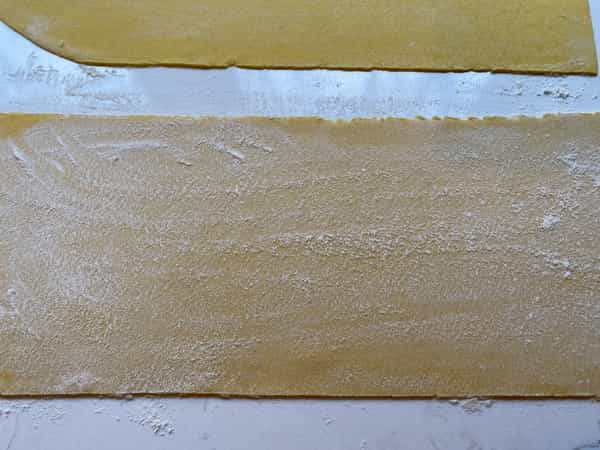
 Place the noodles in a loose bundle on a floured sheet tray and cook right away or allow them to sit at room temperature for a couple hours.
Place the noodles in a loose bundle on a floured sheet tray and cook right away or allow them to sit at room temperature for a couple hours.
 You can even place the tray of noodles in your freezer; once they are frozen solid, transfer the noodles to a baggie and return to the freezer. Always cook frozen noodles from their frozen state- no defrosting required.
You can even place the tray of noodles in your freezer; once they are frozen solid, transfer the noodles to a baggie and return to the freezer. Always cook frozen noodles from their frozen state- no defrosting required.
To cook the noodles, bring a pot of generously salted water to a boil, and cook until they are al dente, which means “to the tooth” in Italian. They should still have some chew.
Unless I’m making a cold pasta salad, I never drain my cooked noodles. For filled pasta and hand-made pasta shapes, I use a skimmer to remove the pasta from the water and place it in my sauce or a serving bowl. For long noodles, I use a pair of tongs. I do this because the pasta cooking water is a critical ingredient, and most recipes don’t stress how important this is. The pasta cooking water is not only well seasoned, but it contains the starches from the pasta. Nine times out of ten, I add a splash or two of the pasta cooking water to help loosen my sauce and create a creamy consistency. Once your pasta and sauce are at the desired stage, then you can drain your water.
Because spring is in the air, I tossed my lemon fettucine with homemade pesto and a couple splashes of my pasta water.
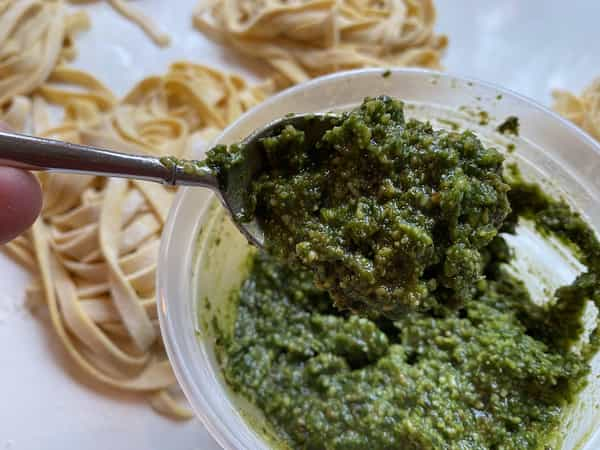
 The lemon flavor from the pasta definitely came through, but I finished the dish with an additional squeeze of lemon juice which made all of the flavors pop.
The lemon flavor from the pasta definitely came through, but I finished the dish with an additional squeeze of lemon juice which made all of the flavors pop.
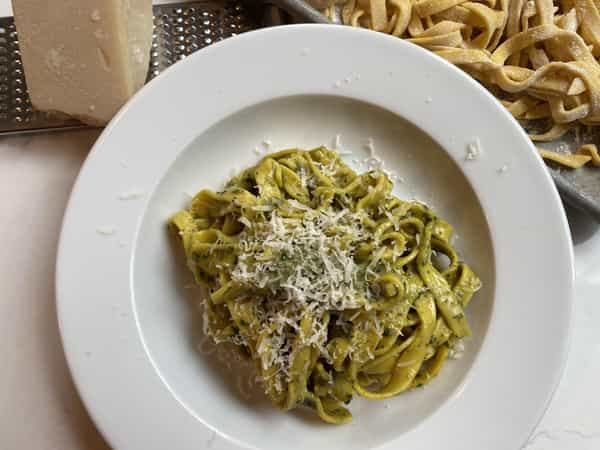
Lemon Pasta Dough
Yield: 3-4 servings
Prep time: 15 minutes
Cook time: 2 minutes
Inactive time: 20 minutes
Total time: 37 minutes
2 cups hard-wheat (“00”) flour (see note, below)
1/4 cup semolina
1 teaspoon ground turmeric
3 eggs
1 lemon, zested
3 tablespoons lemon juice
- In a medium-size bowl, mix together the flour, semolina and turmeric.
- Make a well in the center of the dry ingredients. Crack the eggs into the well, and add the lemon zest and lemon juice.
- Using a fork, beat the eggs and lemon together while gradually mixing the dry ingredients into the wet.
- When the mixture becomes too thick, transfer the dough onto your work surface. Using your hands, knead the dough until smooth and elastic, 5 to 7 minutes. Wrap the dough in plastic, and allow to rest for at least 20 minutes.
- Roll out in a pasta maker until smooth, then roll into sheets and cut into desired noodles.
- To cook and serve, plunge into rapidly boiling salted water. Cook until tender, about 2 minutes, and serve at once with your favorite sauce.
Don’t miss your opportunity to learn how to make pasta and gnocchi from scratch, so sign up for our Homemade Pasta and Gnocchi Workshop classes before they fill up!
If you want to take a deep dive into all things pasta, then our Pasta Boot Camp on July 26 is calling your name!

